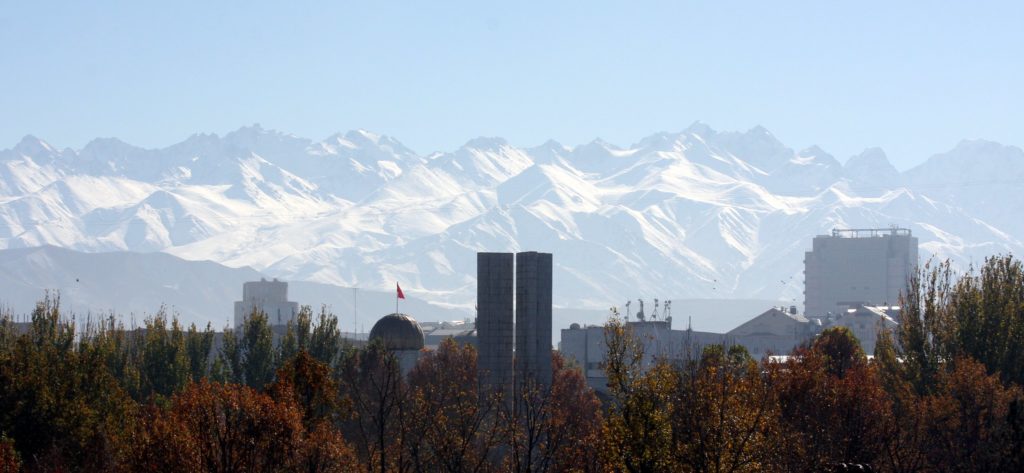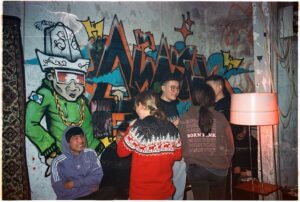As winter arrives in Bishkek, the sun does not shine on Kyrgyzstan’s capital city and the inhabitants have to live in a constant cloud. This is no fog created by winter precipitations, but a grey haze, slowly intoxicating the residents. That smog has become one of Bishkek’s pressing problems over the past few years.
On November 7, 2021, the capital of Kyrgyzstan was the city with the highest level of polluted air in the world, with an AQI of 269 (Air Quality Index), the AQI norm being 100, describes Kyrgyz media Kloop. A year ago, Bishkek was already the city with the highest level of polluted air in the world, pointed Kyrgyz press agency 24.kg, and has been several years in the top of the cities with the most polluted air in the world.
For more news and analysis from Central Asia, follow us on Twitter, Facebook, Telegram, Linkedin or Instagram.
According to the ecological organization Movegreen, the causes of air pollution are coal heating and other kinds of heating, chaotic urban development, the increasing number of cars, frequent temperature inversions, and the absence of winds.Illegal settlements are mostly affected
But the smog most affects residents living in illegal buildings, where hundreds of thousands of people from the different regions of Kyrgyzstan live in cramped conditions, says Movegreen. One of these areas is Archa-Beshik, standing in the south-east part of Bishkek. Archa-Beshik is located only 40 minutes from the center of the capital, but it creates a sharp contrast against the background of luxury houses, smooth cobblestones, and trendy coffeeshops of the center.Read more on Novastan : Kyrgyzstan: why Bishkek’s air quality is so poorIn the newly-built neighborhood, roads are uneven: some residents are lucky to have asphalt, others only have gravel covering, and the unluckiest ones have to walk through mud and slush. This also reflects on the architecture of Archa-Beshik, where uniform buildings are chaotically located next to run-down barracks. Occasionally, some rich mansions with covered courtyards can be found among the buildings of Archa-Beshik.The first residents arrived in the late 1990s, and the neighborhood then started to build up, attracting more and more people from the other regions of the country and those in search of a cheap plot to purchase. The plots in Archa-Beshik now cost tens of thousands of dollars, and wealthy people come here to build mansions away from the city fuss.
36-year-old Aliya Baktiyarova (name changed) lives in Archa-Beshik and moved here from Kemin 20 years ago, when the demand for land in illegal buildings was not so high. Aliya Baktiyarova lives here with her husband and mother-in-law, raising up three children and expecting a fourth one.
“When you have nothing to feed your children and not enough money, the smog is the least of your worries”
The family lives on one of the alleys, in a modest single-story accommodation; while Aliya Baktiyarova and her husband are working, her mother-in-law looks after the children. She works as a seamstress, not far from home: every day at 9 am, Aliya Baktiyarova sits down at her sewing machine and only stops working at 9 pm. Now seven months pregnant, with her big belly, under the rumble of the sewing machines, she deftly sews dresses for hours on end, sometimes stretching her sore back.The one rule in the sewing workshops is the following: the more you sew, the more you get paid. And the Baktiyarovs really need money, as the police officer’s salary of Aliya Baktiyarova’s husband of 14 000 soms (£122) is not enough to feed the family.With the cold weather, the Baktiyarov family has more expenses: they need to dress the children and heat the house. The family has been heating with coal for many years; this year, they bought five tons of coal, at 5 000 soms (£43) per ton. “When you have nothing to feed your children and not enough money, the smog is the least of your worries. The smog is not only harmful to the children, but also to old people, who get sick. It is very harmful. But we don’t have a choice, if we don’t heat the house, the children will get sick. We’d rather use firewood, but it burns too fast”, Aliya Baktiyarova explains to Novastan.At the moment, only one company, Gazprom Neft, provides gas supply for houses in Kyrgyzstan. In order to supply your house with gas, you have to build a gas pipe to the house from the main pipes, costing 600 soms (£5.22) per meter. Then, you need to buy a boiler, costing tens of thousands of soms, and pay 18 soms (£0.15) per cubic meter of gas.
Gas is too expensive for most…
In Archa-Beshik, very few houses are connected to gas heating, it is expensive for most of the families living here, like the Baktiyarov family and their neighbors.To bring gas to their alley, the family and their neighbors need to gather about 22 000 soms (£191) from each house for laying the pipes. Aliya Baktiyarova and her husband barely managed to gather the amount for their contribution, but their neighbors are in no hurry for gas supply. “We can’t buy a stove at the moment, because the cheapest one costs 25 000 soms (£217.8). The good ones cost anything from 70 000 soms (£610). In total, altogether with the equipment, it would cost 100 000 soms (£871). If the state had come up with government support, had provided stoves, or at least had conducted them for free, many people would have agreed. So now, until every neighbor on the whole alley does not gather about 22 000 soms, we won’t be connected. On 20 people, five can’t afford to chip in”, Aliya Baktiyarova says.
…but not for everyone
A few kilometers away from the Baktiyarovs, lives another family, the Smanovys: they have been living for already four years in a paved beige mansion. Gulnur Smanova is 55 years old, she is an experienced businesswoman and used to live in Kazan, Russia, where she spent several decades of her life. She moved to Archa-Beshik in search of a quieter place far from the concrete jungle to spend her old age.In Kyrgyzstan, Gulnur Smanova makes things to order and her children sell them in Russia. She lives in Archa-Beshik with her husband, her son, her daughter-in-law and her three grandchildren. She installed gas supply in her house in 2019, as soon as it was proposed to her; it costed her 150 000 soms (£1 307), which was not too big a cost for her. “There wasn’t any difficulty in conducting gas. Everything went normal. Our two-story house is 280 square meters. In Bishkek, there’s only one cold month during winter. Since the house is well insulated, we only pay 15 000 soms for the cold month, and about 9 000 (£78) for the other months [for gas bill]. We’ve been heating the house since October, because we have very young grandchildren”, Gulnur Smanova says to Novastan.According to her, her family no longer goes out for walks in winter because of the smog. On top of that, some of her neighbors constantly heat with coal, causing a black stream of smoke from the pipes to get into other houses. “But I understand them. People have different budgets. Connecting to gas is expensive. It would be better if people and cars would switch to gas. But it all comes down to money”, Gulnur Smanova regrets.
Authorities are selling discounted coal
In Kyrgyzstan, gas is a luxury, and most residents prefer more affordable local coal from Karakeche mines in the Naryn region, in the center of the country. The same coal is also used at the Bishkek thermal power plant, one of the largest consumers of coal.The coal of Karakeche is not only cheaper than gas, but also much cheaper than the coal imported from Kazakhstan. Nevertheless, the ecologists of Movegreen consider it to be brown coal, which has a higher ash content than the imported one. It also has a lower heating value, which means that people need to heat their house more often.Since mid-November, the Kyrgyz authorities have opened a point of sale for coal at a discounted price in order to provide economic support to the citizens. While a ton of coal from Karakeche was sold for anything from 5 000 soms (£43.6), the authorities sold it for about 3 000 soms (£26.1), described KyrgyzCoal (KyrgyzKomur) in a Facebook post.This led to thousands of people waiting in line for several days, hoping to buy cheaper coal. Among those people, Aliya Baktiyarova’s husband waited for several days, succeeding to purchase some of discounted coal. “My husband received two tons, and it was brought to us within a week. There were a lot of people. In order to get more coal, you had to wait in line again. Some people bought this coal for 3 000 soms a ton, and then resold it somewhere else for 5 000”, Aliya Baktiyarova says.
Saving money to buy coal
40-year-old Nurzhigit Kyrgyzbayev, a resident of Enesay estate and a father of five, was also waiting in line. On November 16, the man reported that he used to heat his house with electric heaters, but because of the ban on their use due to the energy crisis, he fully switched to coal. “My position in line was number 1080. I waited in line for four hours. During the heating season, we spend more money, at least 15 000 soms (£130.7) for coal. We start saving money already during fall. There’s a limitation on electricity, and gas is expensive to install. At least they’re giving that. The stress is now on coal, because common people now all use it to heat their houses”, he says to Novastan.While Nurzhigit Kyrgyzbayev was standing in line for coal, a serpentine of people wanting to save money despite the cold and the slush formed. Demand for coal increased in 2021 due to restrictions on the use of electric heaters: Kyrgyzstan faced an energy crisis in 2021 because of seasonal water shortages in the Toktogul reservoir, described American media Eurasianet.
“We will end up with a lot of health issues, like allergies and heart diseases”
The Kyrgyz authorities have repeatedly raised the issue of the smog over the capital’s sky, but it did not go beyond the stage of discussions. On December 16, Azamat Temirkulov, head of the Department for Analysis and Monitoring of reforms of the presidential administration, declared the importance of fighting the causes of the smog, but did not offer any solutions, relays Kyrgyz media Kaktus. “Our citizens are heating with coal in private houses and housing estates. Around Bishkek, there are 47 housing estates located in the eastern, northern, and western parts of the city. Those places are heated with coal. There is also the problem of the vehicles and their exhausts in the center of the capital, as well as chaotic urban constructions and the lack of wind blowing over the city”, Azamat Temirkulov reported, without proposing any solution.During the Parliament convocation in December 2021, legislator Baktybek Turusbekov also declared that the government did not take any measures and did not interact with the Parliament. “Several Prime ministers asked for this issue to be solved, and among them Akylbek Zhaparov. Not a single point of the program for the eradication of air pollution has been resolved, there are only statements. A city with a million of residents is breathing this; we will end up with a lot of health issues, like allergies and heart diseases”, Baktybek Turusbekov declared to 24.kg.On December 22, the economist Kuban Choroyev declared to Novastan that the type of heating used is directly linked to the level of income. According to him, if the price and the policy concerning conducting gas stay the same, Bishkek will continue breathing smog for many more years to come. “Many would switch to gas, because it’s convenient and not more expensive for heating than coal. But if you count installation, boiler and other expenses, it goes up to more than 1,000 dollars. Most people can’t afford it and prefer to spend less money on coal”, Kuban Choroyev explains. “The industry should pursue a better policy, for example, they could connect people to gas for free, and instead charge a little bit more monthly, along with the gas bill. There’s a failure in the industry. […] If the connection policy was changed, the capital could be fully connected to gas in three years.”
Aizirek Imanalieva Independent journalist based in Bishkek
 Kyrgyzstan: Poverty hides behind Bishkek’s smog
Kyrgyzstan: Poverty hides behind Bishkek’s smog 



